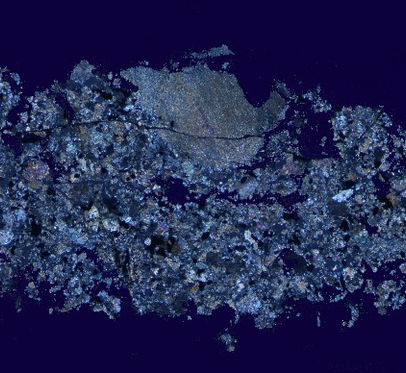top of page
PATRIMÔNIO
Stony
TYPE:
CLASS:
CLAN:
GROUP:
SUBGROUP:
TYPE PET:
SHOCK STG:
WEATHERING:
COUNTRY:
YEAR:
DESCRIPTION:
CHONDRITE
ORDINARY
H-L-LL
H
-
6
-
-
BRAZIL - MG
1950
Equilibrated Ordinary Chondrite L6.
PETROGRAPHY:
The meteorite exhibits a very little chondritic texture, having only a few discernible chondrules in the middle of the matrix. The visible chondrules vary in shape (from rounded to elongated), in size (0.3 to 1.8mm, with an average of 1.2mm) and in internal texture (barred, porphyritic, poikilitic and granular). The meteorite also has a finely crystalline material (formerly glassy) occurring as a very rare constituent of the chondrules and the matrix. Source: Gomes & Keil (1980).
GEOCHEMISTRY:
Through an optical microscope and electron microprobe it was observed that the meteorite consists of olivine Fa24.8, pyroxene bronzite Fs20.7 and plagioclase Ab82.1 An11.3 Or6.6, with the metallic FeNi and troilite occurring in a smaller quantity. Accessory minerals are Ca-rich pyroxene (diopside) En47.6 Fs8.5 Wo43.9, chromite and whitlockite. Source: Gomes & Keil (1980).
CLASSIFICATION:
The classification for the chemical group L is based on the compositions of olivine, pyroxene and chromite. This classification is confirmed by the total chemistry and the Feº / Ni (4.45), Fe / SiO2 (0.54) and Feº / Fe (0.24) ratios, as well as the concentration of total Fe in the meteorite (21.51%) and total FeNi of 6.25%. The type 6 petrographic classification, according to Van Schmus & Wood (1967), is due to the high recrystallization of the matrix, with grains of clear and interstitial plagioclase, very poorly defined chondritic texture and the compositional homogeneity of olivines and pyroxenes. Source: Gomes & Keil (1980).
CLASSIFIERS:
Not reported by the Meteoritical Bulletin Database. According to Gomes & Keil (1980), a summary with the chemistry and petrography of the meteorite was carried out by Santos (1972). A more detailed description was published by Gomes et al. (1978a).
HISTORY:
The Patrimônio meteorite fell in the morning of August 6, 1950, in Morro Cavado, also known as Patrimônio, near the city of Conceição Aparecida. The fact that Morro Cavado is also called Patrimônio caused the name of the meteorite from Conceição Aparecida to be changed to Patrimônio, confusing and using the coordinates of the city of Patrimônio near from Prata. It is not known how the coordinates were changed. The fall was accompanied by a hiss and bangs. At least 20 fragments were recovered weighing between 6000g and 1,800g. Description obtained in the documents of National Museum.
All information that does not have a specific source was extracted from the Meteoritical Bulletin Database.
All images are copyrighted.
bottom of page


